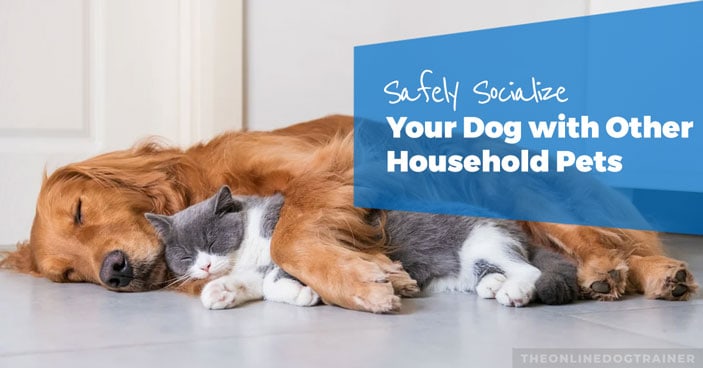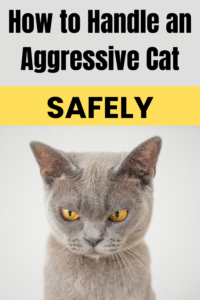Dealing with aggressive cat behavior can be difficult for cat owners, especially if you have children or other pets in the house. Understanding the reason for your cat’s aggression is the first step to getting in solved.
In this post, we’ll cover:
-
- Types of Cat Aggression
- Why is My Cat Being Aggressive?
- Cat Aggression Toward Other Cats
- Cat Aggression Toward Dogs
- Cat Aggression Treatment
- How to Handle an Aggressive Cat Safely
- Tip Regarding Violent Cat Aggression
- My #1 Recommendation for Cat Training
WATCH MY VIDEO: aggressive cat behavior
This post contains affiliate links. If you make a purchase, I’ll earn a commission (at no extra cost to you). As an Amazon Associate, I earn from qualifying purchases. I donate 10% of my earnings to animal charities.
6 Types of Cat Aggression
According to cat expert, Jackson Galaxy, aggression in cats is not uncommon, but it’s unusual for a cat’s aggressive behavior to be serious enough for people to seek professional help.
Cat aggression is treatable. But doing it correctly will likely take considerable time and effort.
There can be many reasons why cats behave aggressively, but these are the most common types of cat aggression.
1. Fear Based Aggression: This is when a cat becomes aggressive because they feel cornered or threatened in some way. Their fear may stem from past negative experiences with animals or people.
The solution is to give the cat an opportunity to retreat. Don’t force interaction. Give them space, and let them learn to feel safer at their own pace.
If you feel your cat is fearful or anxious, read my post, What is Cat Anxiety? (includes video).
You also might check out my post, Cat Stress Relievers: 10 Things That Stress Your Cat Out (includes video).
2. Territorial Aggression: Evidence of this would be the cat attacking people or other pets who come near their stuff or their space.
Cats are territorial in general and often feel like they have to defend their belongings and their environment from potential threats.
Make sure your cat’s feelings are taken into account whenever a new pet or person enters the picture. Realize your cat may feel threatened by this. Also make sure your cat doesn’t have to compete for food, water, litter box, toys, or your attention.
3. Play Aggression: Play aggression is more common in kittens than adult cats, but it’s common regardless of age. I like to see it as a kitten learning how to be ferocious! They’ll be practicing their attack skills by pouncing, biting or scratching while playing, which can sometimes get too rough.
I had a kitten named Miss Abigail who constantly attacked my older cat. I asked the vet what to do and he said her attacking behaviors would stop within the first year.
The poor older cat graciously put up with it and the two were extremely close for years once the attacking nonsense stopped (that’s the two of them in the picture).
The solution to play aggression is to redirect the kitten or cat to toys (instead of your hands and feet!) You also might “practice” with your cat, playing then stopping when they get rough.
Resume playing only when their behavior is appropriate and stop playing if they’re getting rough. With enough repetition, they’ll get the picture.
You might want to check out my post, How to Stop a Cat from Biting (includes video).
4. Misplaced Aggression: This is also known as redirected aggression. This is when the cat is frustrated for some reason and decides to take it out on a person or another pet.
For example, if your cat sees another cat out the window and becomes overly excited or agitated by that, then they may lash out at another pet or person just out of frustration.
I saw this recently with two French Bulldogs. They’re owned by a woman who works in an office near where I live. On my walks, I sometimes see the two of them sitting inside the front glass doors of the building (they’re adoreable…Chuck and Jack lol)
Anyway, one time I decided to approach the glass just to acknowledge and speak to them, and Oh My God, did all hell break loose! They both got so unbelievably excited then suddenly turned on each other and it broke out into a fight!
I felt so bad. This is an example of what misplaced aggression looks like. There’s something going on, and they don’t know what to do with their feelings and excitement (or anger, or fear…) so they just let loose on whoever is nearby.
The solution to redirected aggression is to remove the trigger if possible, and try to prevent a similar situation from occurring in the future.
Whenever your cat behaves this way, take a good look around and see if you can determine what’s causing it. Then try to remove the trigger. Be careful about removing the cat from the situation. It can be dangerous to handle or approach a cat who’s in a state of aggression.
You may have to let the cat handle the thing on it’s own, then wait until the cat calms down to try to figure out what caused the upset.
5. Petting Aggression: Cat owners are often baffled by this one. You’re sitting on the couch with your beloved cat. The cat is purring and snuggling while you’re petting them.
Then all of a sudden, ATTACK! They scratch or bite you.
My cat, Whiskers (that’s him in the pic) does this sometimes. Luckily, he doesn’t scratch or bite hard. But whenever he does it, I keep my arm still and quietly say, “Biting mommy is never the right thing to do.”
You have to give them the instant consequence of your affection stopping abruptly if they bite or scratch. Do this enough times, and they’ll begin to put two and two together and realize it’s the biting or scratching that’s making mommy stop petting them.
Also realize that cats can sometimes have a tolerance breaking point for certain types of stimulation. They may actually get too excited or stimulated by the petting and can’t help suddenly biting or scratching. You can see evidence of this if your cat’s ears flatten or if their tail is twitching, for example.
The solution for petting aggression is to pay attention to how much petting is tolerable for your cat. Stop if there’s a negative reaction from the cat. And stop petting them instantly if they bite or scratch, and don’t resume petting until they’re behaving appropriately.
One more thing. Make sure your cat has enough exercise and mental stimulation. Make sure they have enough cat toys, especially interactive cat toys.
Providing a scratching post may also help to alleviate some of that ferocious energy. And always make sure you play with your cat for at least a few minutes every day.
6. Medical Related Aggression: One of the first things any pet owner should do if their pet becomes aggressive is to make sure the animal is not injured or in pain.
This is especially true if the aggressive behavior comes on suddenly and is out of character for them.
If your cat is displaying aggressive behavior suddenly, doesn’t want to be approached or touched, or has any behavior changes such as eating, toileting, etc., consult your veterinarian right away. The cat may be in trouble and needs your help!
Why is My Cat Being Aggressive?
We’ve discussed common types of cat aggression. Now let’s dive deeper to determine the situations where your cat behaves aggressively.
The more we can pinpoint common situations or triggers, the easier it will be to get it solved.
Most cats won’t attack without warning. It’s up to us as cat owners to understand how to read our cat’s body language respond appropriately.
For help on this, check out this eBook called, Cat Language Bible. It’s a fantastic resource for learning how to communicate with and understand your cat. You can read my full review of the Cat Language Bible here.
Cat Aggression Toward Other Cats
My first experience with cats being aggressive toward each other was many years ago when I owned a brother and sister. They always loved each other and never had any problems.
One day I was in the kitchen making chicken salad and I decided to throw a piece of chicken on the floor for them.
They both lunged at it and immediately broke out into a scary, hissing, snarling fight!
I admit that was really dumb. But ugh…
If you have multiple cats who aren’t getting along, read my post, How to Stop Cats from Fighting and How to Break Up a Cat Fight. Both include a video. You’ll learn some of the reasons why cats don’t get along and ways to solve it.
Cat Aggression Toward Dogs
Having pets who don’t get along is terrible. And it’s terrible for the pets as well.
If your cat doesn’t like your dog, check out this free tutorial from Professional Dog Trainer and Behavioral Specialist, Doggy Dan called, How to Safely Socialize Your Dog With Other Household Pets. His tips will help you keep the peace!
Cat Aggression Treatment
Never punish your cat for being aggressive. It will only make it worse. I know it feels like the cat is angry and being mean, but it’s far more likely they’re upset in some way.
Consider the types of cat aggression we’ve discussed and you’ll realize there’s a reason why they’re doing it, and that reason isn’t pleasant for them.
Here are some tips for dealing with cat aggression:
Create a calm environment. I don’t think people realize just how sensitive most cats are. It really doesn’t take much to upset a cat. Remember, cats are prey in the wild. They’re a bit fearful by nature and constantly in self-protection and survival mode.
Don’t make your cat live in chaos or a hostile environment. And don’t make them find themselves in uncomfortable or upsetting situations.
Provide places for your cat to escape when they feel afraid, stressed out, agitated or overwhelmed.
Give your cat positive encouragement. Reward calm behavior with attention and treats. Be loving and attentive with your cat and help them feel safe in the world they live in.
Make sure their needs are met and they don’t feel they have to fight to protect their stuff.
Get professional help. If your cat’s aggression is severe, consult a cat behaviorist for help. Your veterinarian may be able to make a recommendation for getting help. Or check out this article, How to Find a Cat Behaviorist Near You.
How to Handle an Aggressive Cat Safely
According to Jackson Galaxy, these are the warning signs of cat aggression and how to handle it.
Cat aggression symptoms: Dilated pupils, ears flattened, tail twitching or whiskers flattening against their face. These are warning signs. Something bad is about to happen!
The trick is to stop whatever’s going on before the cat feels it’s necessary to take it to the next level. And never engage with an aggressive cat or try to restrain them. And certainly don’t react aggressively with yelling or hitting.
Don’t make things worse. Back away and give them space. Then once they’ve calmed down, use the tips in this post to determine what brought it on.
You can get more tips about handling aggression behaviors in my post, Why Do Cats Hiss? (includes video).
Tip Regarding Violent Cat Aggression
In my post I mentioned about how to break up a cat fight, I talk about this tip. If your cat is fully engaged in aggressive behavior like attacking another cat or the dog, for example, you can use an open umbrella to scoop either the attacking cat or the other animal out of the altercation.
It’s a way to break it up with less chance of you getting bitten or scratched. And as I explain in that post, it gives the other animal a chance to escape.
I can’t express enough how important it is to protect yourself when you’re dealing with an aggressive cat. Cat scratches and bites can be serious. If you’ve ever had a frightened cat leap from your chest, leaving bloody slashes across your skin, you know what I mean!
Cat claws are sharp. Cat teeth are sharp. And you can actually become seriously ill if you’re scratched or bitten by a cat. For more information, read my post, What is Cat Scratch Disease? (includes video).
Don’t Give Up on Your Cat!
Solving cat aggression can be time consuming. It may take time, patience and compassion.
But by following the tips in this post, and getting additional help from your vet or a cat behaviorist if needed, you can calm your cat down and restore peace in your home.
Complete Cat Training Guide
If you need more help with your cat’s aggressive behavior or any other cat behavior problems, I can recommend a fantastic cat training eBook called, Complete Cat Training.
This program covers 25 cat behavior problems. It provides step-by-step instructions on how to transform your cat’s behavior!
You can read my full review of the cat training guide here.
Understanding Cat Behavior Issues
Why Do Cats Bite Their Owners?
Cat Stress Relievers – 10 Things That Stress Your Cat Out
How to Stop Cats from Fighting
How to Break Up a Cat Fight Safely
How to Stop a Cat from Urinating on the Bed
How to Get Your Cat to Use the Litter Box and Why They Won't
I Donate to Animal Charities
Thanks so much for visiting my website! I hope the information I’ve provided will help you get control of your cat’s aggression. Don’t give up on your cat!
If you make a purchase using some of the links on my website, I will receive a small commission at no extra cost to you. I donate 10% of my profits to these animal charities.
If you found this helpful, please pass it along to other cat owners! Thanks so much. Debra





















